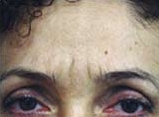Guide to Botox Injection
Reviewed by the physicians of Columbia’s Plastic Surgery Team, May 2025
Botox is a non-invasive cosmetic procedure that injects a small amount of botulinum toxin into the facial muscles to reduce the appearance of wrinkles and fine lines.
- Botox works by blocking nerve impulses, temporarily paralyzing the muscles that cause wrinkles, giving the skin a smoother and more refreshed appearance.
- Botox injections are the most popular non-invasive cosmetic procedure for both men and women.
- Botox is also used to treat conditions like hyperhidrosis (excess sweating), muscle spasms, and migraines.
What is Botox?
Botox is an FDA-approved cosmetic procedure that injects a purified form of botulinum toxin into a muscle to block nerve signals and keep the muscle from contracting.
How is Botox Made?
Botox is made from Clostridium botulinum, a type of bacteria that, if consumed in large doses, can cause a nerve disorder called botulism. However, the specific neurotoxins used in Botox are grown in a lab, where they are sterilized and diluted for safety.
Why Would Someone Get Botox?
Cosmetic Botox can be used to temporarily reduce wrinkles and other signs of aging, including:
- Crow's feet
- Forehead furrows
- Frown lines
- Marionette lines
- Neck bands (platysma muscle)
Because Botox blocks nerve signals that control muscles, it can also be used to treat:
- Pain
- Excessive sweating (hyperhidrosis)
- Crossed eyes (strabismus)
- Overactive bladder
- Migraines
Who is a Good Candidate for Botox?
Cosmetic Botox may be a good choice for adults who want to temporarily reduce signs of aging and fatigue on the face and neck.
Is Botox Safe?
Botox has been extensively studied and is considered safe when administered by a licensed provider.
How Is the Procedure Performed?
Botox is an office-based procedure that takes about 10-15 minutes. Your provider will mark the treatment areas and then inject the appropriate amount of Botox to achieve the desired results.
How Much BOTOX Will I Need?
The exact amount (measured in units of Botox) will vary based on your specific needs and what areas of the face are being treated.
Will the Injections Hurt?
Most patients say the treatment feels like a slight pinch.
What Are the Risks?
Botox is considered safe when the appropriate dose is administered, but temporary side effects may occur. These include:
- Pain, swelling, or bruising at the injection site
- Drooping eyelids
- Asymmetries
In rare cases, side effects may include:
- Allergic reaction
- Botulism-like symptoms
- Muscle weakness or paralysis
- Swallowing or breathing problems
- Heart problems
- Vision problems
How Do People Prepare For the Procedure?
Patients should tell their providers about any medications they are taking, since some types of medicine can increase the risk of bruising and redness.
What Type of Anesthesia is Used?
Botox does not require anesthesia. If pain from the injections is a concern, topical anesthetics can be used to numb the area first.
What Is Recovery Like?
In most cases, people can return to work and resume normal activities immediately after treatment. Patients should stay upright for three to four hours and avoid physical exertion for 24 hours.
How Long Until Results are Visible?
Results start to appear in 24-48 hours, with full results visible in 30 days.


How Long Will the Results Last?
Botox results can last up to 4-6 months.
Can Additional Botox Treatments Be Given Once the Results Wear Off?
Yes, Botox is safe for regular treatments.
Will Insurance Cover the Procedure?
Cosmetic Botox injections are typically not covered by insurance. Botox to treat medical conditions may be covered, depending on the condition and insurance plan.
Next Steps
If you’d like to learn more about Botox or other cosmetic procedures, our team at Columbia is here to help. Call us at (212) 305-3103 or request an appointment online. We accept a number of insurance plans, and our team can help confirm your coverage.
Related
Related Treatments
- Brow lift
- Chin Surgery
- Face Lift (Rhytidectomy)
- Injectable Fillers
- Cosmetic Nose Surgery (Rhinoplasty)
- Cosmetic Ear Surgery (Otoplasty)
- Cosmetic Eyelid Surgery (Blepharoplasty)
- Neck Lift
- Breast Augmentation
- Breast Reduction (Mammoplasty) & Gynecomastia (for men)
- Breast Lift (Mastopexy)
- Liposuction
- Arm Lift Surgery (Brachioplasty)
- Body Contouring After Weight Loss (Body Lift & Thigh Lift)
- Tummy Tuck (Abdominoplasty)
- Scar Revision Surgery
This content has been created by Columbia’s Health Guide Team. Learn more about our efforts to bring you the clearest, most accurate, and most human health resources available.
